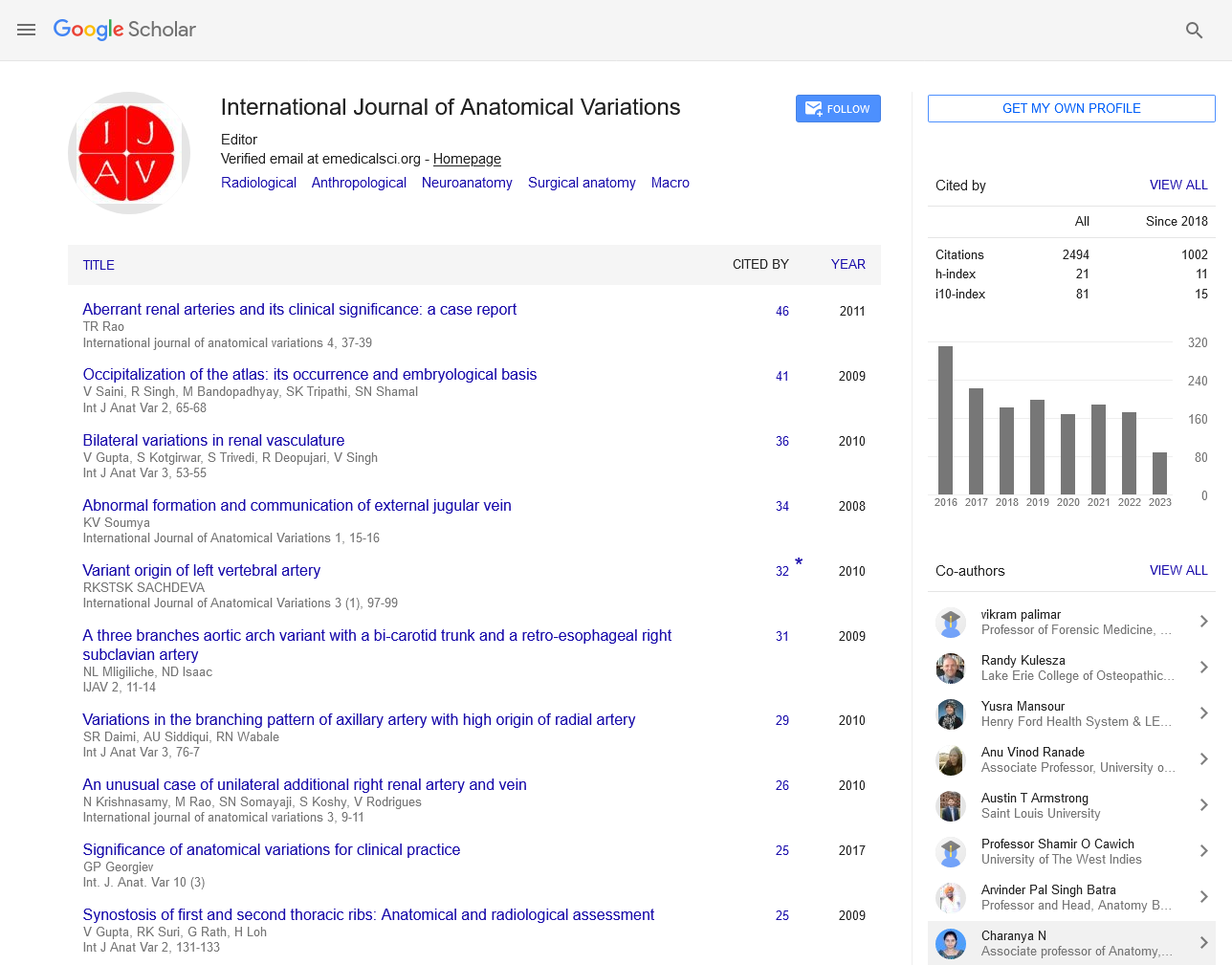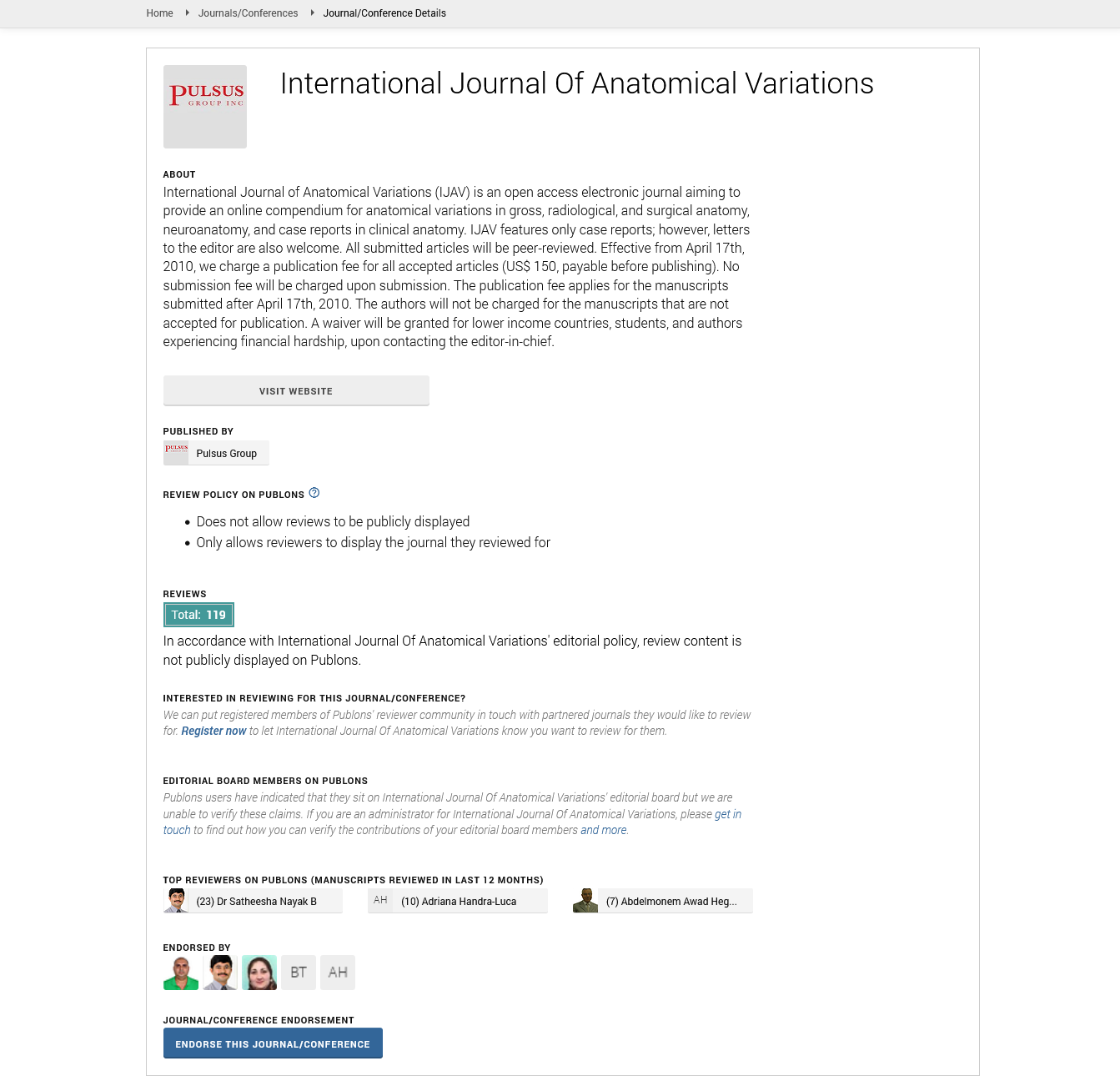Variation in the origin of Gastroduodenal Artery: A Case Report
2 Assistant Professor, Department of Anatomy, Hamdard Institute of Medical Sciences and Research, New Delhi, India
3 Professor, Department of Anatomy, All India Institute of Medical Sciences, New Delhi, India
Received: 30-Oct-2024, Manuscript No. ijav-24-7307; Editor assigned: 02-Nov-2024, Pre QC No. ijav-24-7307 (PQ); Reviewed: 18-Nov-2024 QC No. ijav-24-7307; Revised: 25-Nov-2024, Manuscript No. ijav-24-7307 (R); Published: 30-Nov-2024, DOI: 10.37532/1308-4038.17(11).451
Citation: Arora P, et al. Variation in the Origin of Gastroduodenal Artery: A Case Report. Int J Anat Var. 2024;17(11): 669-670.
This open-access article is distributed under the terms of the Creative Commons Attribution Non-Commercial License (CC BY-NC) (http://creativecommons.org/licenses/by-nc/4.0/), which permits reuse, distribution and reproduction of the article, provided that the original work is properly cited and the reuse is restricted to noncommercial purposes. For commercial reuse, contact reprints@pulsus.com
Abstract
The gastroduodenal artery emerges posterior and superior to the first part of the duodenum from the common hepatic artery. The lower boundary of the first part of the duodenum gives rise to the right gastroepiploic and superior pancreaticoduodenal arteries. During routine dissection, we reported a variation in the origin of the gastroduodenal artery (from the celiac trunk). Such type of arterial variations requires complete preoperative evaluation in various surgical procedures.
INTRODUCTION
The gastroduodenal artery (GDA) is a terminal branch of the common hepatic artery that mainly supplies the pylorus of the stomach, proximal duodenum, and head of the pancreas [1]. Due to its proximity to the posterior wall of the first part of the duodenum, GDA is one of the most important sources of upper gastrointestinal bleeding-mostly secondary to peptic ulcer disease or erosive malignant ulcers [2]. GDA is a terminal branch of the common hepatic artery along with the proper hepatic artery. It passes inferiorly behind the first part of the duodenum to the left of the common bile duct, where it gives off the supraduodenal artery [3]. Inferiorly, GDA relates to the head of the pancreas [4]. More inferiorly, it bifurcates into two arteries at the upper border of the pancreas: 1. right gastroepiploic artery runs forward between the pancreas and first part of the duodenum and passes left into the greater omentum at the head of the pancreas, and runs along the greater curvature of the stomach to anastomose with the left gastroepiploic artery (from the splenic artery) 2. Superior pancreaticoduodenal artery divides into anterior and posterior branches which encircle pancreatic head and anastomoses with similar branches of inferior pancreaticoduodenal artery from the superior mesenteric artery [4].
CASE REPORT
We reported a rare variation in the origin of the gastroduodenal artery (from the celiac trunk) during the routine dissection of a male cadaver in the gross anatomy laboratory at the Department of Anatomy, Hamdard Institute of Medical Sciences and Research, New Delhi. In the present case report, apart from giving origin to left gastric, splenic, and common hepatic arteries, the celiac trunk also gave origin to the gastroduodenal artery (Figure 1). Imaging was done using a Canon EOS R50 with a 24.2-megapixel effective resolution. The camera supports high-speed electronic shutter capture, achieving up to 15 fps for JPEG (max 28 frames) and up to 7 fps for RAW. It also offers a burst rate of 12 fps for JPEG (max 42 frames) and seven fps for RAW. The focal length ranges from 18 to 45mm (29 to 72 mm in 35mm equivalent), with a maximum aperture of f/4.5 to 6.3.
DISCUSSION
The present case reported a rare variation in the origin of gastroduodenal artery in a male cadaver, the artery was found to be originated from the celiac trunk. During development, celiac trunk is the first ventral branch of abdominal aorta, emerging at T12 vertebral level. This trunk is divided into three branches (left gastric, splenic and common hepatic arteries), participate in the irrigation of abdominal viscera [5]. A previous cadaveric study reported that 90.5% of the sample presented the classic pattern of trifurcation of celiac trunk [6]. Another study observed that the trifurcation of celiac trunk in left gastric, splenic and hepatic arteries common in 82.0% of the sample [7]. Zagyapan, et al. found the classic trifurcation occurred in 62.5% of the patients [8]. Some cadaveric studies worldwide reported complete absence of celiac trunk [5,7,9-11]. The absence of celiac trunk occurs due to complete regression of anastomoses of the primitive arteries [5]. In 2018, Petrella et al. observed the origin of only one branch i.e. the common hepatic artery from the celiac trunk. They also reported the origin of gastroduodenal artery from celiac trunk [7]. Clement et al. found out that in the cases, where four terminal branches were seen originating from celiac trunk, an accessory branch was observed for irrigation of the abdominal structures [6].
CONCLUSION
Arterial variations are very important in abdominal operative procedures and they need to be known in order to avoid complications in clinical medicine during radiological and surgical interventions. The knowledge of abdominal vascular anatomy is very important for surgeons and radiologists to perform many of the clinical diagnostic evaluations.
ACKNOWLEDGEMENTS
Our sincere thanks to Hamdard Institute of Medical Sciences, New Delhi. The authors also sincerely thank those who donated their bodies to science so that anatomical research could be performed. Results from such research can potentially increase humankind’s overall knowledge, improving patient care. Therefore, these donors and their families deserve our highest gratitude.
ETHICAL STATEMENT
The authors state that every effort was made to follow all local and international ethical guidelines and laws that pertain to the use of human cadaveric donors in anatomical research.
CONFLICT OF INTEREST STATEMENT
The authors declare that they have no conflicts of interest with the contents of the case report.
FUNDING STATEMENT
This research received no external funding.
AUTHORS CONTRIBUTIONS
Conceptualization: PA; Methodology and Resources: PA, MAK; Writing—original draft preparation: PA, RD; Writing—review and editing: PA, MAK, RD. All authors have read and agreed to the published version of the manuscript.
REFERENCES
- McMinn RMH. Lasts Anatomy Regional and Applied. Churchill Livingstone. 2003 ISBN: B0084AQDG8.
- Vascular and Interventional Radiology: The Requisites (Expert Consult - Online and Print), 2e (Requisites in Radiology). ISBN: 0323045847.
- Standring S. Gray's Anatomy.
- Ryan S, McNicholas M, Eustace SJ. Anatomy for Diagnostic Imaging. 2011 ISBN: 9780702029714.
- Fahmy D, Sadek H. A case of absent celiac trunk: case report and review of the literature. 2015;46(4):1021-1024.
- Clement MI, Barco MA, Ahumada N, Simon C, Valderrama JM, et al. Anatomical variations of the celiac trunk: cadaveric and radiological study. Surg Radiol Anat 2016;38(4):501-510.
- Petrella S, Rodriguez CFS, Sgrott EA, Fernades GJM, Marques SR, et al. Anatomy and Variations of the Celiac Trunk. 2007;25(2):249-257.
- Zagyapan R, Kurkçuoglu A, Bayraktar A, Pelin C, Aytekin C. Anatomic variations of the celiac trunk and hepatic arterial system with digital subtraction angiography. Turk J Gastroenterol 2014;25(1):104-109.
- Badagabettu SN, Padur AA, Kumar N, Reghunath D. Absence of the celiac trunk and trifurcation of the common hepatic artery: a case report. 2016;15(3):259-262.
- Prakash, Rajini T, Mokhasi V, Geethanjali BS, Sivacharan PV, et al. Coeliac trunk and its branches: anatomical variations and clinical implications. Singapura Mad J 2012;53(5):329-331.
- Ugurel MS, Battal B, Bozlar U, Nural MS, Tasar M, et al. Anatomical variations of hepatic arterial system, coeliac trunk and renal arteries: an analysis with multidetector CT angiography. BR J Radiol 2010;83(992):661-667.
Indexed at, Google Scholar, Crossref
Indexed at, Google Scholar, Crossref
Indexed at, Google Scholar, Crossref
Indexed at, Google Scholar, Crossref







